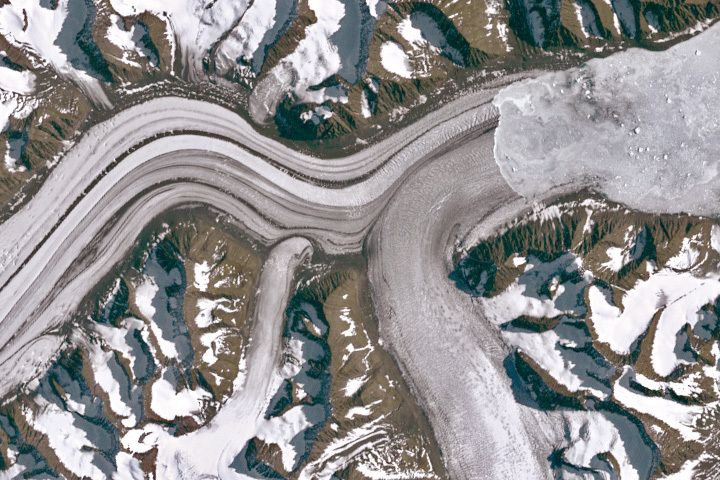
Update on April 23, 2024: This image shows Sortebræ, a large surge-type glacier in eastern Greenland, on September 6, 1986. Congratulations to Steward Redwood for being the first to correctly identify the glacier. Read more about the glacier and see how it has retreated in recent decades in our Image of the Day story.
Every month on Earth Matters, we offer a puzzling satellite image. The March 2024 puzzler is shown above. Your challenge is to use the comments section to tell us where it is, what we are looking at, and why it is interesting.
How to answer. You can use a few words or several paragraphs. You might simply tell us the location, or you can dig deeper and offer details about what satellite and instrument produced the image, what spectral bands were used to create it, or what is compelling about some obscure feature. If you think something is interesting or noteworthy, tell us about it.
The prize. We cannot offer prize money or a trip on the International Space Station, but we can promise you credit and glory. Well, maybe just credit. Within a week after a puzzler image appears on this blog, we will post an annotated and captioned version as our Image of the Day. After we post the answer, we will acknowledge the first person to correctly identify the image at the bottom of this blog post. We also may recognize readers who offer the most interesting tidbits of information. Please include your preferred name or alias with your comment. If you work for or attend an institution that you would like to recognize, please mention that as well.
Recent winners. If you have won the puzzler in the past few months, or if you work in geospatial imaging, please hold your answer for at least a day to give less experienced readers a chance.
Releasing comments. Savvy readers have solved some puzzlers after a few minutes. To give more people a chance, we may wait 24 to 48 hours before posting comments. Good luck!




This is the Columbia Glacier in southern Alaska. This rapidly retreating tidewater glacier is one of the fastest moving glaciers in the world. It spills out of the Chugach Mountains into Prince William Sound.
It’s two retreating glaciers, one large and the other much smaller.
I think the image show a glacier, probably located in Santa Cruz Province, Argentina.
It is fhe Sortebrae Glacier on the Blosseville Kyst (Coast) of eastern Greenland at 68.770125 N, 27.045179 W. The image shows a glacier with stripes of stones parallel to the flow. Another cleaner glacier without strips merges with it on the right of the image just before the merged glacier reaches the sea in a fjord and calves as shown by the white psrt on the right with no stripes. The coast must be just right of the image. The shadows are on the left and top sides of the ridges which, assuming mornind sun, means north is the top left and that this is an east or south east cosst. Combined with mountains and no trees narrows it down to the esst cosst of Greenland.//
Greenland glacier retreat
– Where it is: I think it is in Greenland
– What we are looking at: At the glaciers
– Why it is interesting: 1) Because the melting of the glaciers is depicting at the same time
2) It is interesting in terms of “glaciers mechanics” as we clearly see in at least three cases the result of the glaciers’ encountering
Winding highway leading into an avalanche. Stevens Pass in Washington state. You can see the wheel tracks on the multi- lane highway and some lanes are more driven than others. Some lanes appear to lead out to a rest stop or viewing areas. There are a few waterfalls at the top of the image.
Vanch-Yakh Glacier
Gasherbrum I
Greenland glaciers
…looks like some place in iceland or Greenland… Maybe Alaska.
And, it also looks like rushing water was suddenly frozen
because that looks like ice on the right side of the photo.
These pictures are of the North or South Pole of Mars.
They have discovered ice and snow there. The perplexing thing is
the other parts shown must have been made during an entirely different
time in space.
Looks like the Jungfrau-Glacier in the swiss alps, or an other glacier in the european alps, but I suppose, it isn’t . . .
I think that it is the congruence of two major glaciers and a minor glacier.
The photo shows the convergence of a number of glaciers and the massive freshwater flows at the mouth due to global warming. Likely Greenland or Alaska.
It is Peyto Glacier in Canada’s Banff National Park that continues to shrink.